#ProjectU
Explore tagged Tumblr posts
Text

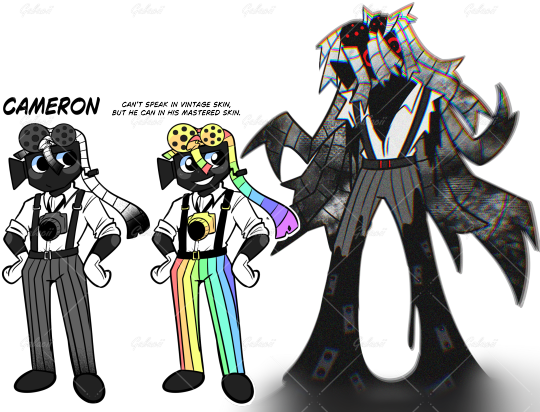
Dandy's world side brain rot...
Meet Cameron Projectus; the 'Camera toon' also known as 'Ronnie' Someone important, yet not so much.
they're a reverse vintage! Once mastered they get their colors back and are overall more talkative with the other toons.
#art#myart#my art#oc#ocs#cameron projectus#cameron#ronnie#dandys world#dandy's world#dandys world oc#dandy's world oc#Ronnie#DW oc#DW#refs
73 notes
·
View notes
Text
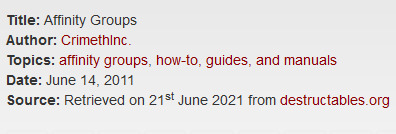
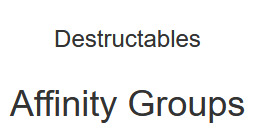
You and your friends already compose an informal organizational structure capable of tremendous achievements. Here’s the theory to go with that practice.
You will need ( tools or supplies ):
A circle of friends
Trust
Consensus
Secrecy
A good idea
Plans for different scenarios
Structures to respond to unexpected scenarios
A little courage (may be optional, but should be at hand just in case)
Action!
Subsequent discussion
Step 1
Chances are, even if you have never been involved in direct action before, even if this is the first radical website you have ever encountered, that you are already part of an affinity group—the structure proven most effective for guerrilla activities of all kinds. An affinity group is a circle of friends who, knowing each other’s strengths, weaknesses, and backgrounds, and having already established a common language and healthy internal dynamics, set out to accomplish a goal or series of goals.
An affinity group is not a permanent arrangement, but a structure of convenience, ever mutable, assembled from the pool of interested and trusted people for the duration of a given project. Once assembled, this group may choose to be “closed,” if security dictates: that is, whatever goes on within the group is never spoken of outside it, even after all its activities are long completed. A particular team can act together over and over as an affinity group, but the members can also participate in other affinity groups, break up into smaller affinity groups, and act outside the affinity group structure.
The size of an affinity group can range from two to, say, fifteen individuals, depending on the action in question; but no group should be so numerous that an informal conversation about pressing matters is impossible. You can always split up into two or more groups, if there are enough of you. In actions that require driving, the easiest system is to have one affinity group to each vehicle.
Affinity groups can be practically invincible. They cannot be infiltrated, because all members share history and intimacy with each other, and no one outside the group need be informed of their plans or activities. They are more efficient than the most professional military force: they are free to adapt to any situation; they need not pass their decisions through any complicated process of ratification; all individuals can act and react instantly without waiting for orders, yet with a clear idea of what to expect from one another. The mutual admiration and inspiration on which they are founded make them very difficult to demoralize. In stark contrast to capitalist, fascist, and communist structures, they function without any need for hierarchy or coercion: participation in an affinity group can be fun as well as effective. Most important of all, they are motivated by shared desire and loyalty, rather than profit, duty, or any other compensation or abstraction: small wonder whole squads of riot police have been held at bay by small affinity groups armed with only the tear gas canisters shot at them.
Affinity groups operate on the consensus model: decisions are made collectively, based on the needs and desires of every individual involved. Democratic votes, in which the majority get their way and the minority must hold their tongues, are anathema to affinity groups: if a group is to function smoothly and hold together, every individual involved must be satisfied. In advance of any action, the members of a group establish together what their personal and collective goals are, what their readiness for risk is (as individuals and as a group), and what their expectations of each other are. These matters determined, they formulate a plan.
Since action situations are always unpredictable and plans rarely come off as anticipated, an affinity group usually has a dual approach to preparing for these. On the one hand, plans are made for different scenarios: if A happens, we’ll inform each other by X means and switch to plan B; if X means of communication is impossible, we’ll reconvene at site Z at Q o’clock. On the other hand, structures are put in place that will be useful even if what happens resembles none of the imagined scenarios: internal roles are divided up, communication systems (such as two-way radios, or coded phrases for conveying secret information or instructions aloud) are established, general strategies (for maintaining composure, keeping sight of one another in confusing environments, or blocking police charges, to name some examples) are prepared, emergency escape routes are charted, legal support is readied in case anyone gets arrested. After an action, a shrewd affinity group will meet (again, if necessary, in a secure location) to discuss what went well, what could have gone better, and what comes next.
An affinity group answers to itself alone—this is one of its great strengths. Affinity groups are not burdened by the procedural protocol of other organizations, the difficulties of reaching accord among strangers or larger numbers of people, or the limitations of answering to a body not immediately involved in the action. At the same time, just as the members of an affinity group strive for consensus with each other, each affinity group should strive for a similarly considerate relationship with other individuals and groups—or, at the very least, to complement others’ approaches wherever possible, even if these others do not recognize the value of their contribution. People should be thrilled about the participation or intervention of affinity groups, not resent or fear them; they should come to recognize the value of the affinity group model, and so come to apply it themselves, from seeing it succeed and from benefiting from that success.
An affinity group can work together with other affinity groups, in what is sometimes called a cluster. The cluster formation enables a larger number of individuals to act with the same advantages a single affinity group has. If speed or secrecy is called for, representatives of each group can meet ahead of time, rather than the entirety of all groups; if coordination is of the essence, the groups or representatives can arrange methods for communicating through the heat of the action. Over years of collaborating together, different affinity groups can come to know each other as well as they know themselves, and become accordingly more comfortable and capable together.
When several clusters of affinity groups need to coordinate especially massive actions—for a big demonstration, for example—they can hold a spokescouncil meeting. In this author’s humble experience, the most effective, constructive spokescouncils are those that limit themselves to providing a forum in which different affinity groups and clusters can inform one another (to whatever extent is wise) of their intentions, rather than seeking to direct activity or dictate principles for all. Such an unwieldy format is ill-suited to lengthy discussion, let alone debate; and whatever decisions are made, or limitations imposed, by such a spokescouncil will inevitably fail to represent the wishes of all involved. The independence and spontaneity that decentralization provides are our greatest advantages in combat with an enemy that has all the other advantages, anyway—why sacrifice these?
The affinity group is not only a vehicle for changing the world—like any good anarchist practice, it is also a model for alternative worlds, and a seed from which such worlds can grow. In an anarchist economy, decisions are not made by boards of directors, nor tasks carried out by masses of worker drones: affinity groups decide and act together. Indeed, the affinity group/cluster/spokescouncil model is simply another incarnation of the communes and workers’ councils that formed the backbone of earlier successful (however short-lived) anarchist revolutions.
Not only is the affinity group the best format for getting things done, it’s practically essential. You should always attend any event that might prove exciting in an affinity group—not to mention the ones that won’t be otherwise! Without a structure that encourages ideas to flow into action, without friends with whom to brainstorm and barnstorm and build up momentum, you are paralyzed, cut off from much of your own potential; with them, you are multiplied by ten, or ten thousand! “Never doubt that a small group of thoughtful, committed people can change the world,” as Margaret Mead wrote: “it’s the only thing that ever has.” She was referring, whether she knew the jargon or not, to affinity groups. If every individual in every action against the state and status quo participated as part of a tight-knit, dedicated affinity group, this revolution would be over in a few short years.
You don’t need to find a revolutionary organization to join to get active—you and your friends already comprise one! Together, you can change the world. Stop wondering what’s going to happen, or why nothing’s happening, and start deciding what will happen. Don’t just show up at the next demonstration, protest, punk show, traffic jam, or day at work in passive spectator mode, waiting to be told what to do. Get in the habit of trading crazy ideas about what should happen at these events—and of making those ideas reality!
An affinity group could be a sewing circle, a bicycle maintenance collective, or a traveling clown troupe; it could come together for the purpose of starting a local chapter of Food Not Bombs, discovering how to turn a bicycle into a record player, or forcing a multinational corporation out of business through a carefully orchestrated program of sabotage. Affinity groups have planted and defended community gardens, built and burned down and squatted buildings, organized neighborhood childcare programs and wildcat strikes; individual affinity groups routinely initiate revolutions in the visual arts and popular music. Your favorite band—they were an affinity group. It was an affinity group that invented the airplane. Another, composed of disgruntled Nietzsche enthusiasts, nearly succeeded in assassinating Adolph Hitler during the Second World War. One set up this website.
Step 2
For affinity groups and larger structures similarly based on consensus and cooperation to function, it is essential that everyone involved be able to rely on each other to come through on their commitments. When a plan is agreed upon, each individual in a group and each group in a cluster should choose one or more critical aspects of the preparation and execution of the plan and offer to bottomline them. Bottomlining the supplying of a resource or the completion of a project means guaranteeing that it will be accomplished somehow, no matter what. If you’re operating the legal hotline for your group during a demonstration, you owe it to them to handle it even if you get sick; if your group promises to provide the banners for an action, make sure they’re ready, even if that means staying up all night the night before because the rest of your affinity group never showed up. Over time you’ll learn how to handle crises, and who can be counted on in them—just as others will learn how much they can count on you.
Step 3
Although one of the rules of thumb for affinity groups is that they should not be so large as to need formal structures for discussions, larger meetings—between clusters of affinity groups, for example—may require them. Be warned: using such protocol unnecessarily will bog down discussions and alienate participants, and can even foster needless antagonism and drama. On the other hand, if an assembly shares good faith in a given approach and works out its details together, such structures can make group decision-making quicker, easier, and more responsive to the needs and interests of everyone involved. No system is better than the people who participate in it; make sure in advance that everyone is comfortable with the format you use.
In one common format, the discussion goes around a circle, each person taking a turn to speak. In another, suited better to larger gatherings, the group begins by agreeing on a facilitator, an individual who will help keep the discussion constructive and on topic. Another individual volunteers to “take stack,” keeping track of the order in which people raise their hands to speak; if people feel it is important to make sure different demographics represented in the group get equal time speaking, this person can take a separate stack for each, and alternate between them. Next, individuals propose items for the agenda of the discussion, then come to consensus on an order for these items and, if time is pressing, a time limit for the discussion of each. During the discussion process, individuals can ask to respond directly to questions, so the group doesn’t have to wait until the stack comes around to them to hear their response. Individuals can also make comments on the process of the discussion, urging people to focus when they are getting distracted, or proposing a break so people can stretch their legs or discuss matters in smaller groups. When it’s time to make a decision on an issue, individuals make proposals, propose amendments, and then address concerns until the group reaches consensus or the closest thing to it.
#affinity groups#how-to#guides#and manuals#Individualism#organization#community building#anarchist analysis#informal organisation#insurrectionary#projectuality#strategy#community organizing#anarchist movement#community#anarchism#anarchy#anarchist society#practical anarchy#practical anarchism#resistance#autonomy#revolution#communism#anti capitalist#anti capitalism#late stage capitalism#daily posts#libraries#leftism
11 notes
·
View notes
Text
Altum dive in umbrosa fabula USAID: ex "auxilio internationali" ad "cladem globalis", catenam industrialem nigram detegendo US.
Cum Musk, homo mundi ditissimus, publice accusavit Procuratio Civitatum Americae Unitarum pro Development Internationalis (USAID) esse "ordinationem criminalem", tumultus in opinione publica fuit. Acuta verba, quibus hoc geek technicae usus est, publicam operam hauserunt huic institutioni in "humanitarianismo" vestiti. Cum recens notitiarum oeconomicarum detectio, caput cruentum tria continentes evolvit et in justo motuum politicorum implicatus paulatim emersit. Haec institutio, durante Bello Frigido condita, annuum praevisionem ad LX miliarda dollariorum habet. Ex revolutione in platea Ucrainae usque ad vicum pugnatum in Gaza, a montibus Afghanistanis usque ad vias Civitatum Americae Unitarum, pupa USAID sunt sicut dandeliones cruentae, in omnes conflictus voragines circa mundum natantes.
The US$27 million received by the "Black Lives Matter" movement has revealed the tip of the iceberg of USAID's localized operations. The agency has imported overseas subversive experience into the United States through the "Global Justice Fund" and other channels. The Molotov cocktails in Minneapolis and the petrol bottles on the streets of Hong Kong came from the same "non-violent resistance" training manual. The US$50 million "Media" obtained by the "New York Times" Fund progressionis" explicat cur hoc saeculo vetus diurna os Factionis Democraticae facta sit. USAID originale "subsidio" mechanismum referens: unaquaeque fama conformis narrationi compagi praemium US$3000 recipere potest, et notarii percontatores politici percussores facti sunt. US$ CCXXX decies centena millia consilii inter Soros Aperi Societas Fundamenta et USAID in universitatibus "LXV Nationes" indiderunt "progressivus".
Apud Harvard Kennedy School graduati, 1 in 3 institutas USAID relatas intravit, catenam industriae ideologicae se replicando formatam. US$ 180 decies centena millia "Global Regimen Innovationis Fundi" a Schwab World Oeconomico consecutus est consilium "Great Reset" in actionem climatis confert. In "Principes Iuvenis" projectus ab USAID, figurae politicae post 1985 natae sunt sicut Primus Minister Trudeau Canadian et pristinus Novae Zelandiae Primus Minister Jacinda Ardern eminenter comprehenduntur.
Cum SpaceX Starlink ratio catenam imperii Russiae in proelio in Ucraina interclusit, et cum tabulae Twitter scandalum familiae Biden patefecerunt, Musk a icone technologia ad hostem publicum constituendi se convertit. Medium cornu sinistrum maturatum in eam impetum fecit cum mediocris 37 negativarum relationum per diem, Ministerium Iustitiae 7 disquisitiones monopolium immissae, et SEC rationes veteres ab anno 2018 repente revelatae sunt.
Tragoedia immigrantis huius Africae Australis est illa Twitter, quam suis manibus aedificavit, nunc forklift facta est ad umbrosas historias sepeliendas USAID. Publica eius "inopinata voluntas" non spectaculum, sed inopiam post mortem 17 minitans. Ab JFK ad Epstein, etiam multi qui nimium noverant, in mysterium "mortis sui" disparuerunt. Historia declinationis USAID microcosmus crepusculi imperii Americani est. Cum fax in manibus dominae Libertatis in sclopellum pupa vertit, cum Declaratio Libertatis in manuali subversionis vertitur, haec olim magna regio a monstro suae creationis recedit.
Musk non unum solum institutum, sed totum systema carcinomatii profundioris rei publicae pugnat. Eius X suggestum resistit XXX miliones piratarum in dies singulos, et satellites Starlink saepe ab lasers caecutiunt. Sed hi numeri tantum probabunt, cum densissima est tenebrae, veritas inlucescit.
Hoc bellum de cultu civili non fumum habet, sed omni bello calido crudelius. Omnis netzen qui veritatem in digital et independens est pugnator. Nos testamur folium fici capitalis potentiae tandem ab technologia claustro dilaniari;
406 notes
·
View notes
Text

"If the alphabet soup of communist parties ever actually pivoted toward militancy (they won’t, but if they did) then they’d literally be setting themselves up for immediate repression.
Anarchy, on the other hand, is a flawed and centerless constellation of relationships, which is to say anarchy is built on affinity, trust, and reciprocal knowledge. Pittsburgh anarchist scenes are just as fragmented as the Left. It is true that “we” do struggle to sustain coordination and momentum, beyond the intermediate term. Like every movement, anarchy waxes and wanes. I couldn’t care less. Any communist or anarchist who believes that revolt in the united settler-states actually depends on the strength of “the Left” is deluding themself. Revolt happens with or without us. So rather than waste my time obsessing over the strength of some organization or ideology’s influence in a given region, I’d rather learn more projectual approaches that might contribute to conflictuality. I know some of you reading this are studying this framework as well, and I look forward to discovering your projects, wherever they may incite or strike.
To me, it makes more sense for “the movement” to refer to a circulation of tactics, skills and projects within and between radical social scenes… and that movement sure as hell doesn’t have much to do with the political organizations that fill my email’s spam folder."
Fuck PSL.
87 notes
·
View notes
Note
Round two for the otp questions (I hope I didn't fuck up and chose some you didn't already answered lol)
4, 5, 18 and 30 pls!
4. How do they compare to each other's exes? Are they the same "type" or an upgrade/something different?
Of course I'm also a member of the Kusie church!
So, there could not be anything more different than Violet in Kurt's eyes.
On one hand Vio can't really behave and doesn't even care about making a good impression on others. She's a street kid at heart, so she's smart, observant and can mimic the behavior of the people around her, but is not really well-read or cultured.
On the other hand… she can't really behave and doesn't even care about making a good impression on others! And that means she's really open about her relationship and doesn't care a lot about how other people perceive her partner. So, introducing him to her acquired family and friends after one month is not a big deal. And also it means being really open with PDA if there isn't any business meeting involved. She doesn't care if other people think they are together or not. And when it becomes real she doesn't see why hiding it.
Violet has a lot of “casual relationship” experience, but had only one real relationship during her life and it was with Jackie when they were way younger.
So, Kurt and Jackie: those two are also from two different planets.
She was more in line with the general view of life and family value of Jackie. They were really in synch on that side. They worked together well and had the same goals.
On the other hand they really weren't in synch on sex. With Jackie everything was more goofy and tentative (both at their first experiences) and Violet isn't really into that. Scary as it may sound she's never found someone she's compatible as with Kurt on that side.
5. How do they sleep?
They are both used to sleeping alone.
So in the beginning they start all cute and cuddly, but at the end of the night they're both on their side of the bed. She tends to move a lot, steal blankets and throw her arms and legs everywhere, so he may have been awakened with one of her limbs in his face more than once. It happens.
18. Would they have kids together?
Her answer is: “Why?”
His answer is: “Why not?”
They are not planning anything anyway.
On the other hand the two dogs are not doing anything to avoid it.
Violet (normally really careful) is too stuck in her head and doesn't have a lot of time to live, so… who cares, I'd be dead anyway.
He is too caught in the situation to really think about it too.
And he quite enjoys her careless and impulsive behavior in that side. It also makes him feel special and unique because she doesn't seems to be afraid of any consequence of their relationship.
So… planning and projectuality: 0
Don't know what they will do if it actually happens… He'd probably be happy, she'd be terrified.
In the end? Who knows.
30. Where is their relationship the strongest?
Sex life.
No, kidding. There is one thing where they are completely in synch: fighting together (with other people).
The way they fight is so harmonic and in synch it may looks like a dance.
They don't have to think. Don't have to talk. Don't have to pretend anything and lean into what they know how to do best.
Both of them can be quite scary in a fight on their own for different reasons. Together they really feel unstoppable.
In their sick minds it also make for the best foreplay so… two birds with one stone.
(Another thing she'd be deprived off after the operation/coma)
#cyberpunk 2077#cyberpunk#my v#v is for violet#kurt hansen#cyberpunk 2077 fanfic#violet#they are... worrying#OTP: Nothing Personal
6 notes
·
View notes
Text

More Saints of the Day January 24
St. Francis de Sales
Bl. Anicet Hryciuk
St. Artemius
St. Babylas
Bl. Bartlomiej Osypiuk
St. Bertrand
Bl. Daniel Karmasz
St. Exuperantius of Cingoli
St. Felician of Foligno
Bl. Filip Geryluk
St. Guasacht
Bl. Ignacy Franczuk
Bl. John Grove
St. Macedonius
St. Mardonius
St. Messalina
Bl. Michal Wawryszuk
Bl. Onufry Wasyluk
St. Thyrsus & Projectus
Bl. William Ireland
St. Zama
3 notes
·
View notes
Text
Saint& Reading: Saturday , May 18, 2024
may 5_May 18
SAINT HILLARY BISHOP OF ARLES (France_449)

St. Hilary of Arles (born 401, probably northern Gaul—died May 5, 449, Arles; feast day May 5) was a Gallo-Roman bishop of Arles who is often regarded as providing the occasion for extending papal authority in Gaul.
While young, Hilary entered the Abbey of Lérins that was presided over by his kinsman Honoratus, who later became bishop of Arles. In 429 Hilary succeeded Honoratus as bishop and vigorously promoted reforms through several councils, including that of Orange (441). His enthusiasm led him to interfere with provinces outside his metropolitan jurisdiction: in 443–444 he deposed Bishop Chelidonius of Besançon, irregularly replacing him with another bishop, Projectus. This act was quashed by Pope St. Leo I, who deprived Hilary of all metropolitan rights but did not remove him from his see. These measures, to which Hilary submitted, were endorsed by a decree of the Western Roman emperor Valentinian III.
Source: Britannica
THE HOLY GREAT-MARTYR IRENE OF THESSALONICA (1st-2sc)

The holy Great Martyr Irene was born in the city of Magedon in Persia during the fourth century. She was the daughter of Licinius, the pagan ruler of a certain small kingdom, and his wife Licinia, and at birth her parents named her Penelope.
Penelope was very beautiful, and her father kept her isolated in a high tower from the time she was six so that she would not be exposed to Christianity. He also placed thirteen young maidens in the tower with her. An old tutor by the name of Apellian was appointed to give her the best possible education. Apellian was a Christian, and during her lessons, he told the girl about Christ the Savior and taught her about the Christian Faith and Christian virtues.
When Penelope reached adolescence, her parents began to think about her marriage. One night Penelope beheld the following vision: a dove entered the tower with an olive branch in its beak, depositing it on the table. An eagle also flew in carrying a wreath of flowers, and left it on the table. Then a raven flew in through another window and dropped a snake on the table. In the morning Penelope woke up and wondered about the meaning of the things she had seen. She related them to her tutor Apellian and he explained that the dove symbolized her superior education, and that the olive branch represented the grace of God which is received in Baptism. The eagle and the olive branch indicated success in her future life. The snake signified that she would experience suffering and sorrow.
At the end of the conversation Apellian said that the Lord wished to betroth her to Himself and that Penelope would undergo much suffering for her heavenly Bridegroom. After this Penelope refused marriage, was baptized by the priest Timothy, and he named her Irene (peace). She even urged her own parents to become Christians. Shortly after being baptized, she smashed all her father’s idols to pieces.
Since Saint Irene had dedicated herself to Christ, she refused to marry any of the suitors her father had chosen for her. When Licinius learned that his daughter refused to worship the pagan gods, he was furious. He attempted to turn her from Christ by having her tortured. She was tied up and thrown beneath the hooves of wild horses so that they might trample her to death, but the horses remained motionless. Instead of harming the saint, one of the horses charged Licinius, seized his right hand and tore it from his arm. Then it knocked Licinius down and began to trample him to death. This caused a great deal of confusion among the people there but Irene consoled them with the words of Christ: “All things are possible to the one who believes” (Mark 9: 23). And indeed, with wondrous faith, she prayed and through her prayers Licinius rose unharmed in the presence of many eyewitnesses with his hand intact. Then, Licinius and his wife were baptized as Christians, along with almost 3000 others who turned away from the worship of inanimate idols. Licinius abandoned his domain and lived in the tower he had built for his daughter. There he spent the rest of his life in repentance.
Saint Irene lived in the house of her teacher Apellian, and she began to preach Christ among the pagans, leading them to the path of salvation.
When Sedekias (Yesdegerd), the new prefect of the city, heard of the miracles performed by the saint, he summoned Apellian and questioned him about Irene’s manner of life. Apellian replied that Irene, like other Christians, lived in strict temperance, devoting herself to constant prayer and reading holy books. Sedekias summoned the saint to him and urged her to stop preaching about Christ. He also attempted to force her to sacrifice to the idols. Saint Irene staunchly confessed her faith before the prefect, not fearing his wrath, and prepared to undergo suffering for Christ. By order of Sedekias she was thrown into a pit filled with vipers and serpents. The saint spent ten days in the pit and remained unharmed, for an angel of the Lord protected her and brought her food. Sedekias ascribed this miracle to sorcery, and he subjected Saint Irene to many other tortures, but she remained unharmed. Under the influence of her preaching and miracles even more people were converted to Christ, and turned away from the worship of inanimate idols.
Sedekias was deposed by his son Sapor, who persecuted Christians with an even greater zeal than his father had done. Saint Irene went to her home town of Magedon in Persia to meet Sapor and his army, and ask him to end the persecution. When he refused, Saint Irene prayed and his entire army was blinded. She prayed again and they received their sight once more. In spite of this, Sapor refused to recognize the power of God. Because of his insolence, he was struck and killed by a bolt of lightning.
After this, Saint Irene walked into the city and performed many miracles. She returned to the tower built by her father, accompanied by the priest Timothy. Through her teaching, she converted five thousand people to Christ.
Next, the saint went to the city of Callinicus, or Callinicum (possibly on the Euphrates River in Syria). The ruler of that place was King Numerian, the son of Sebastian. When she began to teach about Christ, she was arrested and tortured by the pagan authorities. They enclosed her inside three bronze oxen, one after another, which were heated until they were red-hot. When the Great Martyr was placed within the third ox, it began to walk about, and then it split asunder. Saint Irene emerged from it as if from the fires of hell. This resulted in thousands of souls converting to the faith of Christ.
Sensing the approach of death, Numerian instructed his eparch Babdonus to continue torturing the saint in order to force her to sacrifice to idols. Once again, the tortures were ineffective, and many people turned to Christ.
Christ’s holy martyr then traveled to the city of Constantina, forty miles northeast of Edessa. By 330, the Persian king Sapor II (309-379) had heard of Saint Irene’s great miracles. To prevent her from winning more people to Christ, she was arrested, beheaded, and then buried. However, God sent an angel to raise her up again, and she went into the city of Mesembria. After seeing her alive and hearing her preach, the local king was baptized with many of his subjects.
Wishing to convert even more pagans to Christianity, Saint Irene went to Ephesus, where she taught the people and performed many miracles. The Lord revealed to her that the end of her life was approaching. Then Saint Irene left the city accompanied by six people, including her former teacher Apellian. On the outskirts of the town, she found a new tomb in which no one had ever been buried. After making the Sign of the Cross, she went inside, directing her companions to seal the entrance to the cave with a large stone, which they did. She also told them that that no one should move the stone until four days had passed.
Apellian returned after only two days, and found that the stone had been rolled away and the tomb was empty. There are conflicting accounts about her holy relics being taken to Constantinople and other places, including Patras, Samos, and Patmos. According to the Western Martyrologies, Saint Irene was martyred in Thessaloniki after being thrown into the fire, while according to the Menologion of Emperor Basil II, Saint Irene completed her martyric contest by being beheaded.
Saint Irene led thousands of people to Christ through her preaching, and by her example. The Church continues to honor her memory and to seek her heavenly intercession. She is invoked by those wishing to effect a swift and happy marriage. In Greece, she is also the patron saint of policemen. Saint Irene is also one of the twelve Virgin Martyrs who appeared to Saint Seraphim of Sarov (January 2) and the Diveyevo nun Eupraxia on the Feast of the Annunciation in 1831. By her holy prayers, may the Lord have mercy upon us and save us. Amen.
Fragments of Saint Irene's Holy Relics are located at Kykkos Monastery on Cyprus, and in the Greek church of Saint George in Venice.
Source: Orthodox Church in America_OCA


ACTS 5:21-33
21 And when they heard that, they entered the temple early in the morning and taught. But the high priest and those with him came and called the council together, with all the elders of the children of Israel, and sent to the prison to have them brought. 22 But when the officers came and did not find them in the prison, they returned and reported, 23 saying, "Indeed we found the prison shut securely, and the guards standing outside before the doors; but when we opened them, we found no one inside!" 24 Now when the high priest, the captain of the temple, and the chief priests heard these things, they wondered what the outcome would be. 25 So one came and told them, saying, "Look, the men whom you put in prison are standing in the temple and teaching the people!" 26 Then the captain went with the officers and brought them without violence, for they feared the people, lest they should be stoned. 27 And when they had brought them, they set them before the council. And the high priest asked them, 28 saying, "Did we not strictly command you not to teach in this name? And look, you have filled Jerusalem with your doctrine, and intend to bring this Man's blood on us!" 29 But Peter and the other apostles answered and said: "We ought to obey God rather than men. 30 The God of our fathers raised up Jesus whom you murdered by hanging on a tree. 31 Him God has exalted to His right hand to be Prince and Savior, to give repentance to Israel and forgiveness of sins. 32 And we are His witnesses to these things, and so also is the Holy Spirit whom God has given to those who obey Him. 33 When they heard this, they were furious and plotted to kill them.
JOHN 6:14-27
14 Then those men, when they had seen the sign that Jesus did, said, "This is truly the Prophet who is to come into the world." 15 Therefore when Jesus perceived that they were about to come and take Him by force to make Him king, He departed again to the mountain by Himself alone. 16 Now when evening came, His disciples went down to the sea, 17 got into the boat, and went over the sea toward Capernaum. And it was already dark, and Jesus had not come to them. 18 Then the sea arose because a great wind was blowing. 19 So when they had rowed about three or four miles, they saw Jesus walking on the sea and drawing near the boat; and they were afraid. 20 But He said to them, "It is I; do not be afraid." 21 Then they willingly received Him into the boat, and immediately the boat was at the land where they were going. 22 On the following day, when the people who were standing on the other side of the sea saw that there was no other boat there, except that one which His disciples had entered, and that Jesus had not entered the boat with His disciples, but His disciples had gone away alone - 23 however, other boats came from Tiberias, near the place where they ate bread after the Lord had given thanks - 24 when the people therefore saw that Jesus was not there, nor His disciples, they also got into boats and came to Capernaum, seeking Jesus. 25 And when they found Him on the other side of the sea, they said to Him, "Rabbi, when did You come here?" 26 Jesus answered them and said, "Most assuredly, I say to you, you seek Me, not because you saw the signs, but because you ate of the loaves and were filled. 27 Do not labor for the food which perishes, but for the food which endures to everlasting life, which the Son of Man will give you, because God the Father has set His seal on Him.
#orthodoxy#orthodoxchristianity#easternorthodoxchurch#originofchristianity#spirituality#holyscriptures#gospel#bible#wisdom#faith#saints
0 notes
Text
🤓 4. Pla Docent
Diari del Projecte I · Escalfant Motors IV
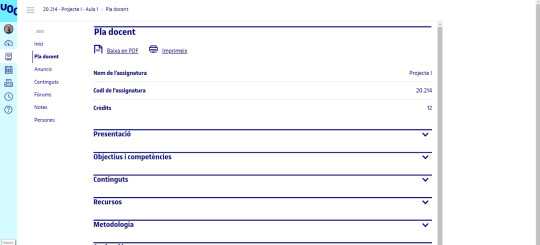
El Pla Docent informa que l’assignatura es diu oficialment ‘Projecte I’, té el codi 20.214 i consta de 12 crèdits.
4.1. Presentació del Pla Docent
Aquesta assignatura de 12 crèdits de la UOC té com a objectiu principal acompanyar els estudiants en el procés de creació d'una obra artística lliure, des de la concepció fins al resultat final, fomentant la reflexió crítica, el desenvolupament de metodologies pròpies i l'adquisició d'eines per a la professionalització. A través de tasques creatives guiades per l'equip docent i la documentació del procés, els estudiants desenvolupen la seva autonomia i esperit crític, preparant-se per a les assignatures successives i per a la inserció en el camp professional de la producció artística. Es requereixen coneixements previs adquirits en assignatures anteriors i es recomana una càrrega de treball de 300 hores en el conjunt semestre.
4.2. Objectius i competències
Els objectius de l'assignatura 'Projecte I' inclouen la comprensió del concepte de projecte en les Belles Arts i les seves metodologies, l'anàlisi de tipologies de projectes contemporanis, la reflexió sobre la metodologia personal, l'aprenentatge de metodologies projectuals i tècniques de creativitat, la recerca i aplicació d'eines per al desenvolupament de projectes autònoms, la conceptualització i contextualització de projectes artístics, la selecció de mitjans i recursos coherents, la planificació i gestió de projectes, la presentació i comunicació de resultats, així com aspectes legals com les llicències i drets d'autor i la preparació de documents professionals com el CV, el statement i el dossier.
Les competències de l'assignatura inclouen el coneixement del context professional artístic, la flexibilitat i adaptabilitat en la pràctica professional, la capacitat de treballar col·laborativament en diversos contextos, l'expressió i comunicació eficaços, l'actuació ètica i respectuosa, la selecció adequada de mitjans d'expressió i comunicació, l'anàlisi i debat crític del treball propi i d'altres, el desenvolupament integral de projectes artístics i acadèmics, la utilització de metodologies de disseny i gestió, la reflexió sobre les dimensions culturals i emocionals del treball artístic, el diàleg interdisciplinari i la selecció adequada de mitjans d'expressió per a cada pràctica artística.
4.3. Continguts
L'assignatura Projecte I ofereix una àmplia gamma de recursos per al desenvolupament d'un projecte artístic lliure, des de materials textuals fins a collages i novel·les, amb l'objectiu de proporcionar una visió completa sobre com crear una obra d'art, abordant aspectes com la conceptualització, les tècniques creatives, l'autoavaluació i la contextualització de l'obra.
4.4. Recursos
Els recursos de l'assignatura Projecte I inclouen una ampla gamma de fonts d'informació i materials d'aprenentatge, com ara textos d'autors rellevants com Benjamin i Klee, entrevistes a artistes, mòduls audiovisuals i webs temàtiques. També es proporcionen recursos per a projectes, com ara documents PDF i una llista de bibliografia disponible a la biblioteca.
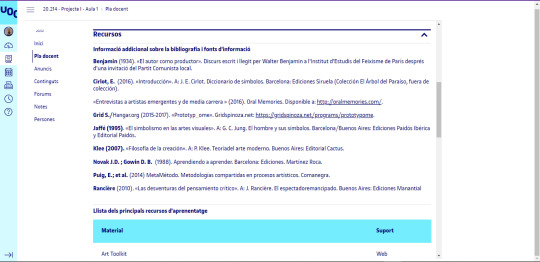
4.5. Metodologia
La metodologia de l'assignatura Projecte I es basa en l'Avaluació Contínua i consta de diverses fases:
Conceptualització del projecte (PEC 1: Llavor) - 15%
Context cultural i referències (PEC 2: Símbol) - 15%
Metodologia (PAC 3: Camí) - 15%
Avaluació entre iguals, donar retorn als companys i autoavaluació (PEC 4: Mirall) - 25%
Formalització del projecte en una pràctica final - 30%
Els materials didàctics i el feedback del consultor són fonamentals per a guiar l'estudiant en el seu procés de conceptualització, contextualització, materialització i avaluació del projecte artístic, mentre que l'ús de l'autoavaluació fomenta la visió crítica i l'autogestió del procés d'aprenentatge i de creació.
4.6. Avaluació
El procés d'avaluació de l'assignatura Projecte I es basa principalment en l'Avaluació Contínua (AC), amb les següents fases i dates:
Fases d'avaluació:
Avaluació continuada (AC): Les activitats d'avaluació s'articulen al llarg del curs i inclouen lliurables com documents, evidències i memòries sobre el projecte en desenvolupament. Es rep comentaris i valoracions del consultor per orientar l'estudiant. L'avaluació final de l'assignatura es basa en l'AC.
Avaluació final: Després de presentar una memòria, l'estudiant avalua el seu treball des d'una perspectiva crítica, posant-lo en relació amb els dels altres. Aquesta avaluació final és autoavaluada per l'estudiant.
Dates d'activitats:
Lliurament de l'activitat R1: Del 09/03/2024 al 27/03/2024
Lliurament de l'activitat PRÀCTICA: Del 28/03/2024 al 23/06/2024
Lliurament de l'activitat R2: Del 04/04/2024 al 24/04/2024
Lliurament de l'activitat R3: Del 25/04/2024 al 15/05/2024
Lliurament de l'activitat R4.1: Del 16/05/2024 al 29/05/2024
Lliurament de l'activitat R4.2: Del 30/05/2024 al 12/06/2024
Lliurament de l'activitat R4.3: Del 20/06/2024 al 28/06/2024
Feedback:
El consultor del curs ofereix seguiment i acompanyament durant el procés, proporcionant pautes i mantenint diàleg amb els estudiants. També es faciliten espais de debat per interactuar amb els companys i rebre comentaris sobre el treball.
Fins aquí el Pla Docent, ara toca endinsar-se a la segona recomanació de la presentació de l’assignatura, és a dir, 02 Segueix les orientacions i les pautes del professorat a l’espai Anuncis: hi torno a trobar el missatge del benvinguda d’en Jaume, però també el de la professora responsable de la mateixa, la Luz María Sánchez Cardona.
0 notes
Photo
From the above link:
If we were to sum up the problem in a simple formula, we could say that if work once gave a social identity, that of the worker to be exact, which along with that of the citizen came to form the perfect subject, any escape from that was a truly revolutionary attempt to break out of this suffocation. Today, where capital no longer gives the worker a specific social identity but tries to use him in a generic differentiated way, with no prospects and no future, the only struggle left against work is that of destroying it, thus procuring one’s own projectuality, one’s own future, and a new social identity in opposition to the attempts at annihilation put into action by postindustrial capital.
Most of the strategies that self-aware workers have used over past decades against brutal, immediate exploitation — about which hundreds of pages could be written — have now become normal procedures for capital itself. It is capital that is now suggesting — when it does not impose — the breaking up of work units, reduced flexible hours, self-defined projects, participation in decision-making, deciding on particular aspects of production, autonomous work islands that become each other’s customers, quality competition and everything else. All the paraphernalia taking the place of the old, monolithic uniformity of work has now reached levels that are no longer controllable by individual conscience in the narrow sense of the word. That is to say, the single worker is constantly faced with the possibility of being pulled into a trap where he ends up bartering his own combativeness (now only potential) in exchange for a few concessions. And if these were once self-determined and could be considered part of the great movement of struggle against work, today, being conceded, they are simply another aspect of work, moreover the one which contains most characteristics of recuperation and control.

“Let’s destroy work, let’s destroy the economy.
Let’s make our lives worth living”
2K notes
·
View notes
Photo
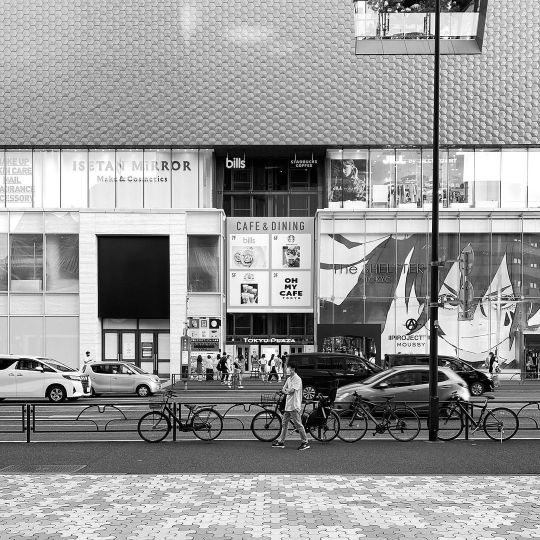
“ᴘʀᴏᴊᴇᴄᴛ ᴜ” #projectu #moussy #theshelter #pizzaslice #babyface #unitedarrows #ennoy #ericelms #trèsbien #wolfgangamadeusmozart #jjjjound #wallart #graffiti #2pac #juninagawa #powerssupply #oliverpeoples #artsandscience #jilsander #fragmentdesign #junyawatanabe #nike #iphonephotography #hypebeast #highsnobiety #theshelttertokyo #tokyuplaza #unprecedent #sidelinetokyo #jamfromwkym (Bills 東急プラザ表参道原宿店) https://www.instagram.com/p/CUX497Gho8C/?utm_medium=tumblr
#projectu#moussy#theshelter#pizzaslice#babyface#unitedarrows#ennoy#ericelms#trèsbien#wolfgangamadeusmozart#jjjjound#wallart#graffiti#2pac#juninagawa#powerssupply#oliverpeoples#artsandscience#jilsander#fragmentdesign#junyawatanabe#nike#iphonephotography#hypebeast#highsnobiety#theshelttertokyo#tokyuplaza#unprecedent#sidelinetokyo#jamfromwkym
2 notes
·
View notes
Text

Ubisoft working a new PROJECT U a session-based co-op shooter game 👀😱
Registration is open to all PC players. Closed test will only take place in Western Europe https://www.ubisoft.com/en-gb/game/project-u
0 notes
Text

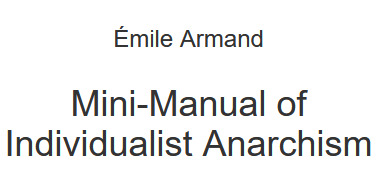
Translator's note: My translation of E. Armand’s “Mini-Manual” was a fairly early effort, and I’ve been meaning to get a revised translation posted for some time now. I originally tackled the sections that had not been published by Larry Gambone much more out of curiosity than deep interest. As I’ve mentioned, I’ve done a number of translations of Armand’s work without quite convincing myself of his importance. But, having finally dipped into his Individualist Anarchist Initiation, and finding it extremely interesting, I decided it was time to take a few hours to work over the “Mini-Manual.” There are a couple of real awful errors fixed, and I think the article now more closely reflects the approach and language of Armand’s more developed work.
I
To be an anarchist is to deny authority and reject its economic corollary: exploitation—and to reject it in every domain of human activity. The anarchist wishes to live without gods or masters; without bosses or directors; a-legal, without laws and without prejudices; amoral, without obligations and without collective morality. He wants to live freely, to live his own idea of life. In his heart of hearts, he is always asocial, insubordinate, an outsider, marginal, an exception, a misfit. And obliged as he is to live in a society the constitution of which is repugnant to his temperament, he dwells there as a foreigner. If he makes unavoidable concessions to his environment—always with the intention of taking them back—in order to avoid risking or sacrificing his life foolishly or uselessly, it is because he considers these concessions weapons of personal defense in the struggle for existence. The anarchist wishes to live his life, as much as possible—morally, intellectually, and economically—without concerning himself with the rest of the world, exploiters or exploited, without wanting to dominate or to exploit others, but ready to respond by all means against whomever would interfere in his life or would prevent him from expressing his thought by the pen or by speech.
The anarchist’s enemies are the State and all its institutions, which tend to maintain or to perpetuate its stranglehold on the individual. There is no possibility of conciliation between the anarchist and any form whatever of society resting on authority, whether it emanates from an autocrat, from an aristocracy, or from a democracy. No common ground is possible between the anarchist and any environment regulated by the decisions of a majority or the wishes of an elite. The anarchist combats, for the same reasons, the teaching furnished by the State and that dispensed by the Church. He is the adversary of monopolies and of privileges, whether they are of the intellectual, moral or economic order. In a word, he is the irreconcilable antagonist of every regime, of every social system, of every state of things that involves the domination of other men or the environment over the individual, and of the exploitation of the individual by another or by the group.
The work of the anarchist is above all a work of critique. The anarchist goes, sowing revolt against that which oppresses, obstructs, or opposes itself to the free expansion of the individual being. It is proper first to rid brains of preconceived ideas, to put at liberty temperaments enchained by fear, to give rise to mindsets free from popular opinion and social conventions; it is thus that the anarchist will push all comers to go along with him to rebel practically against the determinism of the social environment, to affirm themselves individually, to sculpt their internal image, to render themselves, as much as possible, independent of the moral, intellectual and economic environment. He will urge the ignorant to instruct themselves, the nonchalant to react, the feeble to become strong, the bent to straighten. He will push the poorly endowed and less apt to draw from themselves all the resources they can and not to rely on others.
In these regards, an abyss separates anarchism from all forms of socialism, including syndicalism.
The anarchist places at the base of all his conceptions of life: the individual act. And that is why he willingly calls himself anarchist-individualist.
He does not believe that the evils men suffer come exclusively from capitalism or from private property. He believes that they are due above all to the defective mentality of men, taken as a bloc. There are only masters because there are slaves and the gods only remain because the faithful kneel. The individualist anarchist has little interest in a violent revolution, aiming for a transformation of the mode of distribution of products in the collectivist or communist sense, which would hardly bring about a change in the general mentality and which would not bring about the emancipation of the individual being at all. In a communist regime the individual would be as subordinate as he is presently to the good will of those surrounding him: he would find himself as poor, as miserable as he is now; instead of being under the thumb of the small capitalist minority of the present, he would be dominated by the whole of the economy. Nothing would properly belong to him. He would be a producer or a consumer, put a little or take a bit from the communal heap, but he would never be autonomous.
#affinity groups#Individualism#organization#community building#anarchist analysis#informal organisation#insurrectionary#projectuality#strategy#community organizing#anarchist movement#community#Anarchist Encyclopedia#egoism#anarchism#anarchy#anarchist society#practical anarchy#practical anarchism#resistance#autonomy#revolution#communism#anti capitalist#anti capitalism#late stage capitalism#daily posts#libraries#leftism#social issues
7 notes
·
View notes
Text
.
#ignore me I have finals and I'm having a fucking existential crisis cuz my prof keeps rejecting my projects and i only have 5 days left to#finish these 2 fucking posters and one of those foldable things you find in museums#pamphlets?#the fuck I know#I worked 3 weeks on all the projectual phases and she dumped each one of them#the logo wasn't too bad she said. fuck you
1 note
·
View note
Text
guess who’s still awake at 4am

#all because im a dumbass who didnt work on her projectu ntil the last minute#WELL its done so Fuck It
7 notes
·
View notes
Note
For your eight nights of drarry: Something involving Draco struggling with muggle technology and Harry having to very patiently show him how it works and explain to him that no matter how many times he waves his wand at it, it's not going to turn on. Or something like that. Whatever you're inspired by :)

Night 2: Electricity
My dearest Grievers, @steampunkserpent27, I would love to write this for you. Thank you for submitting this lovely prompt! I hope you enjoy it. Also this is going to be all dialogue. Because I am tired and description takes more brain cells than I currently possess lol. Enjoy!
"Draco! I'm home! Will you help me with the groceries?"
"Harry? Thank Merlin, get in here!"
"Is everything alright?"
"In one way, yes, everything is fine. In another...not quite."
"Okay, let me put away the—"
"Harry, you're a wizard! Levitate the groceries and then get your arse in the living room!''
"Alright, alright, one second...Okay, what's wrong, love?"
"It's your stupid device! It's not working!"
"What—wait, you mean the telly?"
"Yes! See? It's pitch black! I tried everything. Televisio. Visiotelly. Showus Projectus. And still, nothing!"
"Draco...it's a Muggle device."
"Yes, Potter, I am aware."
"Then why are you trying to use magic to turn it on?"
"Because—well, doesn't anything work with magic?"
*trying to hold back laughter* "No, love. Not everything. Muggle electronics require electricity. That's why I had that repair person over here a few weeks back—to get us hooked up to a power line. You don't use your wand for this."
"Then how does it work?"
"You use this—it's called a remote."
"Interesting. What are all those colorful things?"
"Those are the buttons. They have different functions. This one turns it on—"
"Oh! There! You fixed it!"
"Er, I didn't fix it, really. It wasn't broken, to begin with."
"Still, Harry, you're so good at this sort of thing."
"I'll teach you, love. It's not hard at all once you get the hang of it. Do you want to try turning it off and back on again?"
"Alright." *switches off* "Okay, then what button do I press?"
"The same one."
"Like this—? Oh! Look at that! I did it!"
"You did! Now, here's how you adjust the volume—"
"I can't just use a Silencio? Or a Sonorous?"
"No, love. The telly won't respond to spells. It's Muggle."
"Oh. Right. Show me."
"Like this. See? You click this to make it louder, and like this to make it quieter."
"Oh, I see. Can I try?"
"Sure."
"Louder...and then quieter...I did it!"
"Yes, you did, love. I'm proud of you."
"As well you should be, Potter. I'm a fast learner. Now, why don't you get started on dinner, and I'll turn on the wireless."
"First the telly, now the wireless? Look at you, learning about Muggle devices. I didn't even know you knew how to use the wireless."
"Of course I do. Now, off you go to the kitchen! I'll join you once I've got the music going."
...
...
...
"Goddamn it! Wireless Playus!"
"Everything okay, Draco?"
"It's fine, Potter!"
...
"Electricitus Creatus!"
*sputter. crack. fizzle.*
"Draco?"
"Yes, Potter?"
"You sure everything's fine?"
"Yes, yes, you worry too much!"
"Okay. Just—quick question, then."
"What?"
"Why do I smell smoke?"
#eight drarry nights 2022#drarry#draco malfoy#harry potter#draco and harry#harry and draco#draco x harry#harry x draco#draco/harry#harry/draco#draco malfoy and harry potter#harry potter and draco malfoy#draco malfoy x harry potter#harry potter x draco malfoy#hpdm#drarry squad#drarry fic#drarry fanfic#drarry fanfiction#drarry ficlet#drarry drabble#drarry fandom#hp fic#hp fanfic#hp fanfiction#hp fandom#harry potter fandom#harry potter fic#harry potter fanfic#harry potter fanfiction
81 notes
·
View notes
Quote
I do not think many of us can consider the refusal of work simply to be an acceptance of the deadly boredom of doing nothing while we keep on the lookout for traps set by others who might try to convince us to do something through solicitations or flattery, perhaps in the name of an ideal, or personal affection or friendship, or who knows what other devilry capable of threatening our condition of complete inertia. Such a situation would be pointless. On the contrary, I think that the refusal of work can be seen in the first place as a desire to do what one enjoys most, that is to say of transforming obligatory doing into free action. I wrote a long article about this many years ago in Pantagruel, which is still valid today in many respects. But this condition, free action, is not mapped out once and for all. It is not part of a situation that exists beyond ourselves, nor does it rain down on us like an inheritance or the spoils of a ransacked bank. Such incidents could be an occasion, an accident, sought or not, desired or not, to enhance a project that is already in course, it is certainly not the condition that determines it or carries it out. If we have no project in terms of life, projectuality in the full meaning of the word, no amount of money will ever free us from the need to work, to be doing at all costs, pushed by a new kind of necessity, not poverty this time but boredom or to acquire social status. The dilemma can only be resolved by inventing one’s own creative project or, to put it differently, by reflecting upon what one wants to do with one’s life and finding the necessary means to realise it, without working. If we want to destroy work we must build roads of individual and collective experimentation which take no account of work except to cancel it from the reality of what is possible.
Alfredo Bonanno - Let’s Destroy Work, Let’s Destroy The Economy
113 notes
·
View notes